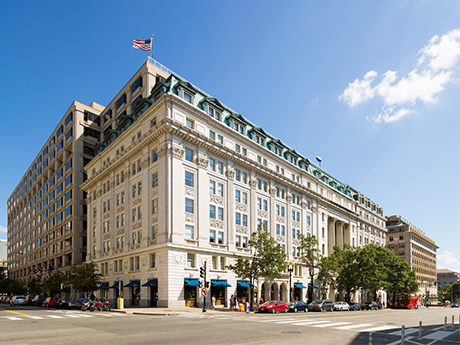Downtown Washington, D.C., is confronting many of the same pandemic-generated challenges as other urban markets across the United States. This includes above-average and record high commercial vacancy (office and retail), as well as lower-than-average daytime foot traffic, in part due to an increase in hybrid work. Yet there is a case to be made that now is a unique moment for leasing office (and retail) space in the District’s central business district (CBD).
The loss of foot traffic has hit downtown retail particularly hard, especially fast-casual dining. Coffee shops and sandwich places that depend on office workers have closed at a higher rate than other food-related retail. But the pedestrians are coming back.
Kastle Systems’ data from the DowntownDC Business Improvement District (BID) shows an increase since Labor Day in the number of workers at their desks, with approximately 42 percent of the pre-pandemic number of employees in-office on a weekly basis, compared with around 33 percent last spring. This is expected to rise as more employers establish return-to-office policies.
Despite 2022’s turbulent economy over the first six months, D.C.’s office leasing activity was up 16 percent compared with the first half of 2021, according to Cushman & Wakefield. The latest round of quarterly brokerage market reports reveals the vacancy rate is hovering around 18 percent (Newmark), and slightly higher for Class B assets. The third quarter was slow, as summers tend to be, resulting in no leases over 100,000 square feet, but there were several small tenant deals and large renewals.
Yet the record office vacancy rate is the District’s CBD is not solely attributable to remote work and attrition. The city has added about 8 million square feet of net new trophy office space over the past four years. This has driven a flight to quality, with tenants choosing to upgrade their offices across all asset classes. In addition, several typical downtown tenants have chosen to relocate to new locations elsewhere in the District, including on the waterfront, which has undergone a renaissance in recent years. This migration has opened up a number of premier downtown addresses that were previously unavailable.
The record level of office vacancy and a strong apartment market have helped fuel interest in office-to-residential conversions, and currently there is 2.5 million square feet of conversions in the DowntownDC BID underway, announced, or projected. This is the first residential construction downtown in more than a decade, and with it will come a new energy.
While some office tenants are leaving the CBD, others are choosing to locate here, driven by convenience and the ability to secure prestigious addresses previously unavailable. It’s clear: a new precedent is being set.
“When you hear something once, it’s interesting. When you hear it over and over, it’s clear a pattern is beginning to emerge,” said Gerren Price, president and CEO of the DowntownDC BID.
According to Price, companies are choosing to be in D.C. because of locational advantages and attributes wrapped around exceptional access: access to transit, access to amenities (restaurants, daycare, hotels), access to talent and access to decision makers.
Several C-suite executives have shared that their decision to locate downtown was a deliberate effort to ease employees’ commutes, enhance their quality of life, and bolster retention. Another commented that his team simply looked at the Metro map: “D.C. is a world-class city — the Paris of North America, and downtown is smack in the center of the region. Why wouldn’t you want to be here?” said Bruno Grinwis, principal of architectural firm HGA.
Who is moving to the District?
Many of the recent leases have been executed by professional services and associations/nonprofits. This includes firms like Boston Consulting Group, which signed a lease for 90,000 square feet across from the White House, nearly doubling its local footprint The American Center for Physics recently announced it will be opening a 30,000-square-foot convening space downtown.
After the successful sale of its conference center in suburban Maryland, National 4-H Council is relocating to a 15,000-square-foot space in the Met Square building. Cravath, Swaine & Moore LLP just signed a 21,000-square-foot lease at 16th and K streets — its second U.S. outpost after New York City.
Jay Scruggs, principal and office director of HGA’s D.C. office said that HGA is expanding its D.C. footprint, taking 17,000 square feet in the historic Woodies Building, because the firm was lured by high ceilings, great floorplates and a central location.
“Moving to one of Washington’s quintessential historic buildings in the heart of the city puts us closer to our clients and offers HGA an extremely visible footprint in downtown Washington via our new second floor storefront,” said Scruggs
Complementing these professional services is the cluster of tech firms that now call the District’s CBD home. This includes Google and Morning Consult, to name a few.
Insiders believe that Amazon HQ2, which sits across the river in Arlington, Virginia, has bolstered the region’s reputation as a tech market. A recent study by CBRE supports that idea: it ranked the D.C. region No. 3 in North America for tech talent.
A lot to offer
Research shows that younger people want to work in urban areas where they can walk, bike or take public transit to work. They also want access to a range of dining options, entertainment and culture.
With numerous museums and cultural institutions, theaters, and green spaces, not to mention restaurants and the Capital One Arena, downtown D.C. offers all of this. It’s the original “15-minute city.”
Considering a move to the District? Now might be the perfect moment to get in.
— By Catherine Timko, Principal and CEO, The Riddle Co.
The Washington DC Economic Partnership and the DowntownDC BID contributed to this article, which was originally published in the November 2022 issue of Southeast Real Estate Business.



